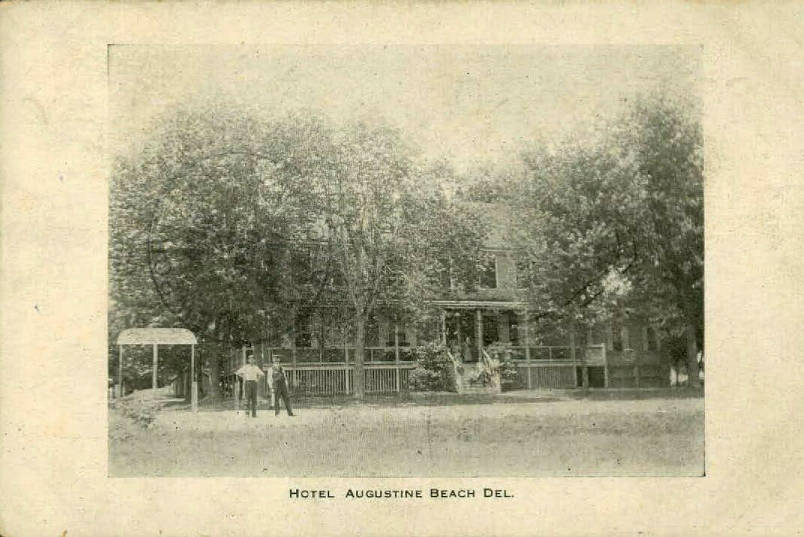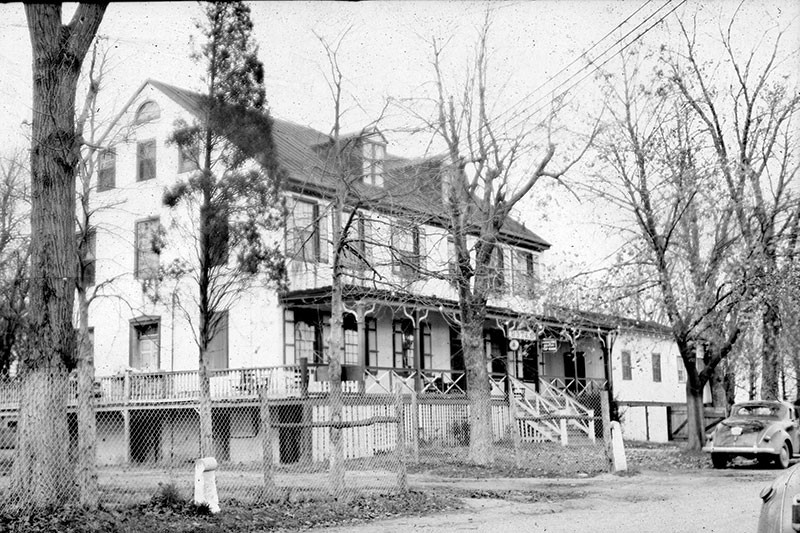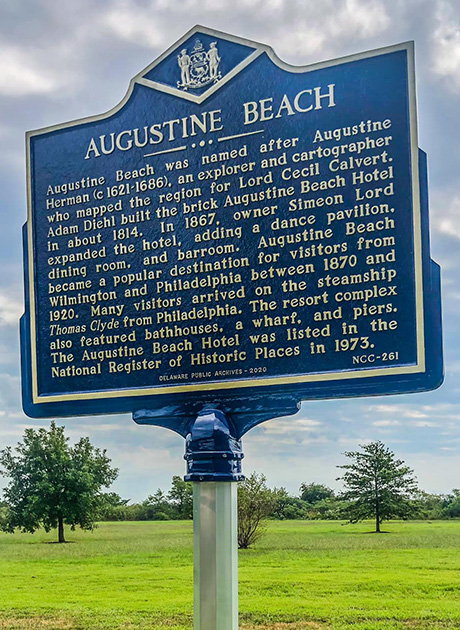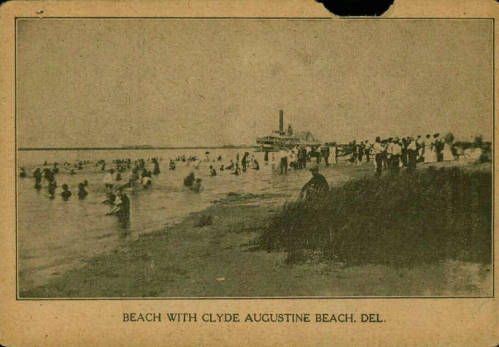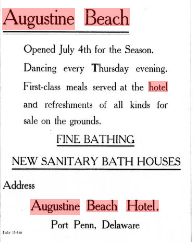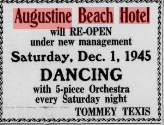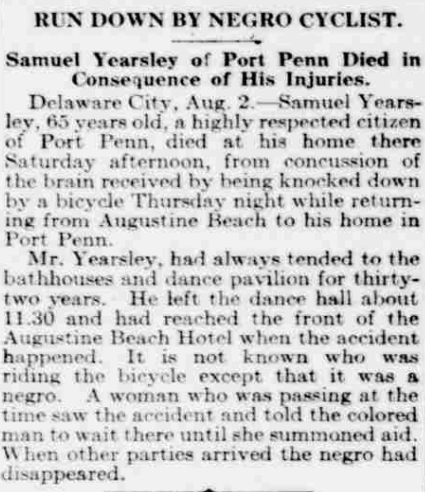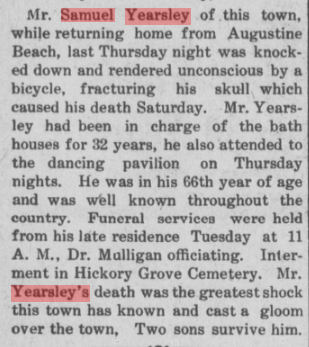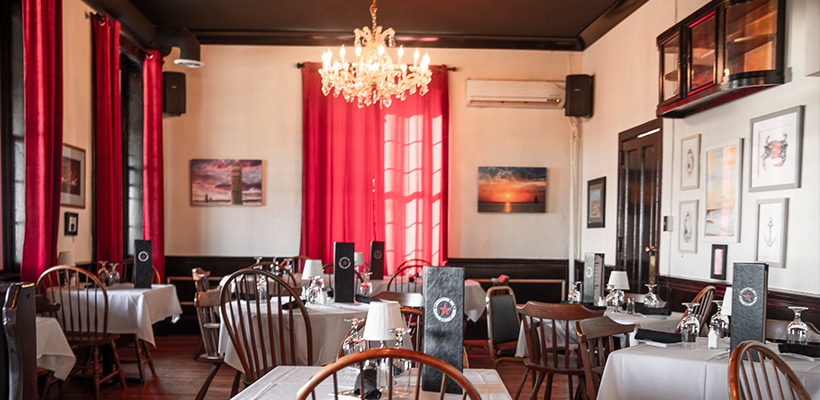Some believe that tragedy and trauma can leave behind an energy that haunts the living, perhaps manifesting as ghosts, which serve as links to the past. Imagine someone enduring something so painful that the strength of their emotion imprints into a place for all eternity.
When you type “Pennhurst” into a Google search bar and hit enter, the results you receive will be inundated with horror, despair and injustice. While I knew some of the basics heading up to Spring City, Pennsylvania last night, I didn’t know the gory details of what happened at Pennhurst after it opened in November 1908.
The Diamond State Ghost Investigators have visited Pennhurst many times, but Sunday night was my first investigation there. I went into it feeling uneasy because, to be honest, my head space hasn’t been clear. I’m grateful to Gina for letting me hitch a ride. The conversation on the way to our investigation was mostly lighthearted and laughter filled. Although, when Andy is in the car you’re guaranteed a myriad of clever sound effects, anecdotes and head-out-the-window antics. Matt and I sat in the back in hysterics for much of the drive. I went into the investigation feeling much lighter, thanks to my ghosty peeps.
Before I dive into what my (sub)team stumbled upon, let’s get some history.

The history of Pennhurst
There is quite a lot of land and several buildings associated with Pennhurst, originally known as the Eastern Pennsylvania State Institution for the Feeble-Minded and Epileptic. The campus is located in Spring City, Pennsylvania, near the Schuylkill River.
There is an upper and lower campus. The lower campus is comprised of sixteen buildings. In 1930, the first buildings on the upper campus, otherwise known as the female colony, were completed and named Pershing, Buchanan, Audubon and Keystone. Capitol Hall was erected after World War II along with Devon constructed on lower campus.
Pennhurst was intended to house no more than 500 residents, but it was overcrowded from the start. By 1957, there were more than 3,500 residents and not nearly rough staff to manage the caseload. Overall, about 10,600 people lived in Pennhurst over its 79 years of operations, with half dying there.
According to the Pennhurst Memorial & Preservation Alliance, the facility was a product of a self-proclaimed “progressive” era when the solution to dealing with disability was forced segregation and sterilization.
During eight decades of continuous operation, Pennhurst evolved from a model facility into the subject of tremendous public scandal and controversy before the federal courts ordered it closed and the remaining residents moved elsewhere
Pennhurst was known for using restraints and tranquilizers on patients as control measures in lieu of adequate staffing. Staff said that patients were restrained for their own protection, such as when a patient charged into walls headfirst. The use of restraints and tranquilizers was a controversial issue, and in 1977, U.S. District Judge Raymond J. Broderick ruled that the conditions at Pennhurst State School violated patients’ constitutional rights.
The ruling led to the eventual closure of the institution in 1987.
The Bad and the Evil
We may never know all of the true details of what happened at Pennhurst. Many of the patients would have been unable to provide testimony. The Pennhurst Longitudinal Study, conducted by the Assistant Secretary for Planning and Evaluation (ASPE), principal advisor to the Secretary of the U.S. Department of Health and Human Services, stated that 86% of the patients were severely or profoundly disabled and slightly more than 50% were non-verbal.
The articles I have found have been stomach-turning and as I’ve typed up this article I have had to take several breaks to compose myself. To start, all of the articles refer to the patients as mentally retarded. The use of the word “retarded” is considered hate speech because it offends people with intellectual and developmental disabilities as well as the people that care for and support them. It alienates and excludes them, and emphasizes the negative stereotypes surrounding people with intellectual and developmental disabilities.
But, we have to remember that it wasn’t until 2010, that President Barack Obama signed “Rosa’s Law,” which changed “mental retardation” to “intellectual disability” in U.S. federal law. It blows my mind that it took so long to come to that conclusion and begin the process of changing this societal term.
Multiple kinds of therapies were offered from group therapy, to physical therapy, art and music therapy. Job postings that circulated in the Philadelphia Inquirer in the 1920s reveal that they were looking for assistance with electric and hydrotherapy.
Fatal punishments and neglect
On March 23, 1937, an article in the Philadelphia Inquirer, talked about the “boxing glove murder” of a 15-year-old boy named Eugene Statler. According to the report, an attendant named William McGraw beat the boy’s head against a wall while wearing boxing gloves because McGraw said the boy had stolen 95 cents. Witnesses said that Eugene pleaded with McGraw to show mercy.
On July 28, 1949, The Philadelphia Inquirer Public Ledger, reported on the death of a 35-year-old inmate of Pennhurst, his name was Lawrence Kern. Lawrence’s Mom did not believe the autopsy from Pennhurt so she hired a private investigator. The findings from the secondary autopsy showed the cause of death to be a brutal beating.
Yet, it wasn’t until 1968 that investigative reporters released a documentary about the heinous crimes happening within the walls of Pennhurst.
In 1969, articles were published in both the Philadelphia Inquirer and the Wilmington Evening Journal, about the death of a 14-year-old girl named Mari Bonli, who was found bleeding from the mouth after drinking a lye-type detergent. During the investigation, other patients were questioned, and they said they saw another patient feed the detergent to the girl. Investigators claimed that they could not take the word of mentally challenged patients. Staff allegedly had nothing to say.
The girl’s mother flew in from Anchorage, Alaska asking for additional help with this matter because she accused the institution of negligence. Her daughter had been a patient for eight years which means she was admitted at the age of six years old. Mari’s mother claimed that her daughter had also been bitten, scratched, and beaten by other patients over the years.
By the time the courts were admitting involvement, the news coming out of Pennhurst was beyond deplorable.
Bringing the darkness to light
Two Supreme Court cases on behalf of Pennhurst residents, as well as a 1968 television news exposé by journalist Bill Baldini called “Suffer the Little Children,” helped bring these issues to light. Warning: The video linked here is traumatic and could be triggering.
In 1974 the United States Supreme Court joined a lawsuit that eventually lead to Pennhurst closing down.
The good news is that the court cases that came out of Pennhurst led to serious disability justice reforms. The 1977 trial court decision recognized a constitutional “right to habilitation” and ordered the complete closure of an overcrowded, dehumanizing facility. The case also led to the development of the “Pennhurst Doctrines,” which established that states could not discriminate against people with disabilities and that people with disabilities had the right to live in the least restrictive environment possible.
Overall, the closure of Pennhurst helped to bring justice to disabled patients who had been mistreated and neglected at the facility. The legal action brought attention to the mistreatment of disabled patients at Pennhurst, helped to recognize the rights of disabled patients to receive appropriate care and treatment, and promoted community living arrangements for disabled patients.
Pennhurst today
Today when you visit the Pennhurst website, you’ll find information about tours and haunted houses. There are documentaries and many videos on YouTube about this location. Several well-known paranormal investigator teams have spent a significant amount of time researching these buildings.
The Diamond State Ghost Investigators have scheduled many private tours. I’m proud to say that our team isn’t looking to sensationalize Pennhurst. Our visits are not about drawing attention to our name. We don’t go in looking to stir up trouble, we go in intending to listen.
The Pennhurst Museum, which is located on the same site as the Mayflower Building, is open to the public and is one of only three physical museums of disability history in the United States.
In May 2023, Pennhurst Asylum hosted the ParaCon Paranormal Convention, which featured famous ghost hunters. Our invite got lost in the mail 😉
There is an interactive horror summer camp experience called the Pennhurst Horror Campout. This “campout” offers a unique and immersive horror-themed camping experience for adults. Campers can expect to be engaged in various quests and challenges while exploring the haunted grounds of Pennhurst Asylum.
There is also a haunted house attraction and it has drawn criticism from some who believe it trivializes the suffering of those who lived there.
The tunnels
At the end of the night, I did pull a few people along with me to head down into one of the tunnels. Sometimes I surprise myself when I venture into the unknown without fear. Especially into a dark tunnel when I’m typically not a fan of tight spaces.
The tunnels of Pennhurst are a network of concrete tunnels that run under the campus, connecting buildings both above and below ground. The tunnel we had access to on Sunday could be accessed from concrete stairs in the center area between buildings. Kyle and I ventured down and had a running commentary of the graffiti on the walls. From biblical quotes to stencils of the Joker, the sentiments upon the concrete covered the length of the tunnels from start to finish. When we got to the end, Kyle peered through a broken window in a door and saw a collection of old wooden chairs piled up. Yours truly had to get on her tippy toes to see. The only strange phenomenon we came across was when we both heard a dog barking.
Were there dogs ever on the grounds of Pennhurst? My research has been inconclusive.
Findings from my group
Quaker Building
There were five of us in the Quaker basement, Ken, Laurie, Jeff, Trey and myself. We sat on uncomfortable dusty chairs in the dark for a good 30 minutes. Trey had set up a laser grid, Jeff set up his camera and infrared light. Ken and Laurie had their REM pods out. I had, well, a grumbly stomach and an audio recorder for an EVP session.
When I did find the courage to speak up while in the basement, I didn’t ask a question, I made a statement. “We have heard about the horrible things that happened here. We’re sorry for what happened to you.” It can’t fix anything, but if there were any spirits listening, I hope they realized it isn’t a game or an adrenaline rush for us. It’s an opportunity to tell their story.
We received a lot of activity during this time. Energy shifts, temperature shifts, movement in the grid and both REM pods were active. At times the REM pod sounded like morse code or a telegram getting submitted. The colors lit the ceiling in red and blue, while surrounded by a bright green grid. I haven’t seen the footage from Jeff, yet, but I am curious to see what it was able to capture. (On that note, I’d like to extend a HUGE thanks to Jeff and Trey for essentially being our camera crew for the night. They are a great duo and our team is extremely lucky to have them.)
Devon Building
I know it’s August, but this building was abnormally hot. It was hot and humid and there was no air movement.
If spirits are anything like me, they stopped moving and interacting altogether due to the sheer heaviness of the air.
We didn’t really get any activity in this building, though we asked. We spent time in the Candyland room, which I bet is creepier in the daytime because the walls are painted like the classic children’s board game with giant lollipops. Weird. I held the go-pro camera during this building and can only imagine how that appears. I so desperately wanted to see something, so the camera would catch my reaction. Alas, it will be a lot of close-up shots of my eyes darting back and forth trying to adjust to the dark.
Members of the team had experienced shadow figures, touching, and overwhelming sensations of something being very close to them in years past. This year, at least for us five, we didn’t experience that. There were cameras set up in the building while no one was there though and perhaps they will capture something we won’t be able to explain away or debunk.
Mayflower Building
Don’t people normally save the best for last?
The basement of the Mayflower building was interesting. There were a lot of toys. There was a room with what looked like church pews and bookcases. The toys, for the most part, were modern. People brought them to try and get young spirits to interact with them. I tried kicking a ball around, but the spirits weren’t feeling it.
We did hear voices, and shuffling and the temperature sensor went off a couple of times, but in a few locations, I was pretty certain I was hearing the Pennhurst staff who were stationed in the welcome center elsewhere in the building. The voices were too clear and seemed to be in conversation. I could be wrong, but my gut says I was near some kind of vent or the staff had walked near the basement stairs.
When we got to the third floor, well above the welcome center, everything changed. There are very few places I have been where the activity just didn’t stop. My sub-group has a TON of activity on this floor and at the end of the night when we all compared notes, our findings were the same. There is a strong presence on the third floor of the Mayflower building and it is intelligent.
A tricky and intelligent haunting
I think there was more than one entity up there. We heard distinct footsteps in multiple rooms and down both halls. When the REM pods went off, Ken would ask if the spirit could step away to turn it off. The sounds would stop. He would prompt the spirit to interact with the REM pod again and it would. This went on for quite some time. At the other end of the hall, Trey, Jeff and I were listening and trying to find where the footsteps were coming from. Sometimes it was a few solid steps and other times it was a full-on sprinting sound.
I wandered off to the stairwell to make sure the staff weren’t coming upstairs. I stood there for quite some time and the only thing I heard or saw was a moth. When I left the stairwell I walked back down the hall towards Ken and Laurie. I peeked in each door, allowing my eyes to adjust to the dark so I could see if any windows were open. Perhaps the running footsteps were noises coming from outside the building, but no one was out there. We were all stationed in our separate places doing investigations.
Seeing double
It was after my stairwell and door check that Trey called my name.
“Christy, were you just in the first room down here?”
I hadn’t been.
I was down the hall with Ken and Laurie, there were about five rooms in between us. When I left the stairwell I had walked the opposite way past the door in question. He asked if I had gone inside the room and walked across it. I hadn’t gone into the room. He went into the empty room to act out what he had seen. Apparently, the figure looked like me, wearing the same jeans and gray shirt. He said I was walking quickly from one side to the other, but upon further inspection of the room, he said that he thought the room extended further based on how quickly I was walking toward where a wall existed. Trey was visibly shaken by this experience.
I fully intend to haunt people in my afterlife, in the kindest, most thoughtful way ever, but as far as I know, I’m alive and kicking. Could Trey’s eyes have been playing tricks on him? Do I have a doppelganger? Was I doing some sort of witchy astral projecting?
Only the spirits left behind at Pennhurst will ever know.
We hear you
The conditions at Pennhurst were truly awful for the patients who resided there. The institution operated under deplorable conditions, with chronic overcrowding and widespread patient abuse. It is important to acknowledge the pain and suffering the patients endured and to ensure that their stories are not forgotten.
The preservation of Pennhurst and efforts to bring awareness to its history allows for a deeper understanding of the injustices that occurred. The spirits of those who suffered and died in this institution deserve an opportunity to be heard and treated fairly, even in death.
If you dare, check out our paranormal evidence vault to hear some of the most compelling evidence of ghosts and other supernatural phenomena. We will be adding more as we review our recordings.













